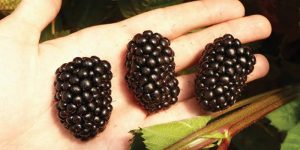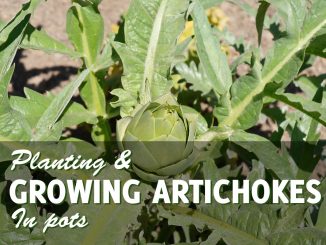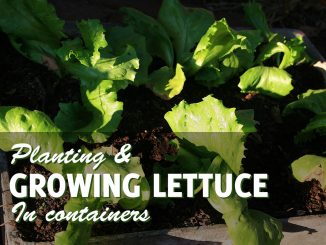
Growing blackberries in containers can be very rewarding. They are very hardy plants that typically can be found growing on the side of any road despite weather conditions and do very well in containers.
They produce berries that are delightfully sweet and rich in vitamin C. Fans of blackberries create delicious and tasty treats out of them, such as pies, crumbles, tarts, as well as jams.
If you like blackberries but do not have the time or cannot find them at a farmer’s market, you may want to consider growing blackberries in containers.
Before You Start Growing Blackberries in Containers
Blackberries like warm, sunny conditions. Plants bloom form from May and continue for quite a while. Southern, low lying regions do not have any problems with flowers getting damaged by frosts. If you live in mountain areas, you have to choose hardy cultivars and opt to place the plants to protect them from the cold. Southern slopes are out of the question for the warm spring makes the cultivars susceptible to frost because the buds open earlier than usual. One of the benefits of growing blackberries in pots is that you can move the plant around and even indoors as needed depending upon the weather.
Opt for the short-caned and upright varieties that do not need trellis support when growing blackberries in pots. These varieties are Arapaho, Apache, and Navajo. They also do not produce stems that have thorns, so you would not have any problems picking them.
Selecting the Right Container to Plant Blackberries
You can only grow one blackberry plant per container. Your container should be at least 12 inches wide and 12 inches deep. A 15-gallon container is highly recommended for growing blackberries in containers since they are heavy feeders.
You have a choice between clay pots, wooden boxes, or plastic containers for your blackberries. Plastic containers are better for container gardening because they hold in moisture well but do not hold in heat, plus they are cheaper compared to other containers. They are also durable and light-weight compared to other pots.
Make sure that you have drilled several drainage holes at the bottom of your container. It will not help your plants if your container retains too much water. Layer the bottom with an inch of small pieces of broken terra cotta pots or small pebbles for added drainage ability.
You can also use a fiberglass netting to help prevent small insects from crawling into your pot. If you live in a warm area, choose a light-colored pot to reflect the heat. If you live in a cool area, choose dark-colored pots to absorb heat. Decorative ceramic pots are often unsuitable because they usually do not have adequate drainage holes at the bottom.
Proper Soil Mix to Grow Blackberries in Pots
Growing blackberries in pots require a different growing media for healthy growth. Ordinary garden soil contains a lot of pathogens such as viruses, fungus, and bacteria that can harm your plant and, as such, is not recommended.
A soil potting mix bought in your local nursery or garden store is best for your blackberry. These potting mixes available have a mix of sterilized soil, perlite, vermiculite, or peat moss, as well as compost for nourishment. The ideal blend is light and will absorb water but drain out any excess.
There are also soilless mixes available; however, they are more expensive and require additional nutrients.
Invest in good quality of either potting mix because cheap ones eventually retain water and become compact. Cheap ones often result in a waterlogged plant with poor air circulation around the roots.
Prepare your soil two weeks ahead before planting. Make sure that the conditions are warm to promote root growth. Your potting mix must have a pH of 5.0-6.5 for optimal growth. Use lime and sulfur to increase and decrease the pH, respectively, until you get the right pH level.
Growing Blackberries From Cuttings
Avoid growing blackberries from seeds, as it is very difficult. It is best to start blackberries from cuttings from an established plant. You can get an established cutting at the local garden store, but I prefer to purchase online since there is a much larger selection. Dig a hole about 3 inches deep and place your cutting in. Give the roots enough room to spread. Cover the roots of your blackberry with soil just below the level of the crown. The crown is the point in the plant where the roots merge with the stem. Pack the soil firmly and water your plant until it goes through the holes. Afterward, cut the stem to about 2-3 inches above soil level to force the plant to create new growth from the crown.
Care and Harvest of Blackberries Grown in Containers
Just give your plants enough water for the first couple of months of growing blackberries in containers. Once your plants become established, give them 10-10-10 or 15-15-15 fertilizer for growth. It would be better if you would incorporate compost into the soil by shallow-tilling the surface. Compost will provide your plants better nourishment as well as prevent weeds from taking over the pot.
Pests and Diseases
Watch out for diseases and pests that can harm your crops. Orange rust, powdery mildew, spider mites, and stink bugs are but a few of the factors that can harm your plants.
Keep them at bay by selecting disease-resistant varieties, pruning off any part of the plant that has symptoms of a disease, and removing any fruiting stems that have already given off fruits for the season.
Keep them healthy by spraying them with compost tea every two or three days. Water them directly on the soil and never let the leaves stay wet for a long time.
Protect your crops from birds when growing blackberries in pots by covering it with a bird-friendly netting system several weeks before the fruits appear. Ordinary netting will only harm the birds when they get caught in it.
Harvesting Your Blackberries

Harvest blackberries when they look full or almost swollen, in deep purple or black color. Red berries are sour and not as moist and rich in flavor. Harvest the berries by carefully pulling the fruits using the tips of your fingers without squeezing them.
Only wash blackberries when you are about to eat them. Eat blackberries soon after picking; they do not store well. You can freeze them, but expect the flavor and quality of the berries to be compromised.
There are also many herb and vegetables you can grow in containers as well. Take a look at our guide on growing chives in pots!




Great information. Thank you! What is “compost tea?” I have never grown blackberries before, but want to give it a try!